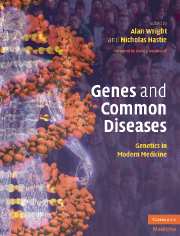Book contents
- Frontmatter
- Contents
- List of Contributors
- Foreword
- Section 1 Introductory Principles
- Section 2 Common Medical Disorders
- 13 Developmental disorders
- 14 Genes, environment and cancer
- 15 The polygenic basis of breast cancer
- 16 TP53: A master gene in normal and tumor suppression
- 17 Genetics of colorectal cancer
- 18 Genetics of autoimmune disease
- 19 Susceptibility to infectious diseases
- 20 Inflammatory bowel diseases
- 21 Genetic anemias
- 22 Genetics of chronic disease: obesity
- 23 Type 2 diabetes mellitus
- 24 Genetics of coronary heart disease
- 25 Genetics of hypertension
- 26 Obstructive pulmonary disease
- 27 Skeletal disorders
- 28 The genetics of common skin diseases
- 29 Molecular genetics of Alzheimer's disease and other adult-onset dementias
- 30 Major psychiatric disorders in adult life
- 31 Speech and language disorders
- 32 Common forms of visual handicap
- 33 Genetic and environmental influences on hearing impairment
- 34 Pharmacogenomics: clinical applications
- Index
- References
18 - Genetics of autoimmune disease
Published online by Cambridge University Press: 17 August 2009
- Frontmatter
- Contents
- List of Contributors
- Foreword
- Section 1 Introductory Principles
- Section 2 Common Medical Disorders
- 13 Developmental disorders
- 14 Genes, environment and cancer
- 15 The polygenic basis of breast cancer
- 16 TP53: A master gene in normal and tumor suppression
- 17 Genetics of colorectal cancer
- 18 Genetics of autoimmune disease
- 19 Susceptibility to infectious diseases
- 20 Inflammatory bowel diseases
- 21 Genetic anemias
- 22 Genetics of chronic disease: obesity
- 23 Type 2 diabetes mellitus
- 24 Genetics of coronary heart disease
- 25 Genetics of hypertension
- 26 Obstructive pulmonary disease
- 27 Skeletal disorders
- 28 The genetics of common skin diseases
- 29 Molecular genetics of Alzheimer's disease and other adult-onset dementias
- 30 Major psychiatric disorders in adult life
- 31 Speech and language disorders
- 32 Common forms of visual handicap
- 33 Genetic and environmental influences on hearing impairment
- 34 Pharmacogenomics: clinical applications
- Index
- References
Summary
Introduction
The autoimmune diseases are disorders where the immune system erroneously targets self-antigens leading to organ specific or systemic tissue damage (Goodnow et al., 2005). These aberrant responses are the results of a breach in tolerance characterized by either cellular or humoral autoreactivity. Examples of autoimmunity occur in most organ systems and include autoimmune responses to the β-cell in the pancreas (Type 1 diabetes), to myelin in the central nervous system (multiple sclerosis), to hepatocytes (chronic active hepatitis), to thyrocytes (Graves' disease or autoimmune thyroiditis), skin (psoriasis or vitiligo), renal basement membrane (Goodpasture's disease), joints (rheumatoid arthritis) or gastrointestinal mucosa (ulcerative colitis or Crohn's disease). Generalized autoimmune diseases such as systemic lupus erythematosus, and system sclerosis also affect multiple organs simultaneously.
Background: genes and environment
The characterization of genetic determinants in disease has been transformed with the availability of the tools and technologies which have emerged from sequencing and characterizing variation in the human genome over the past 20 years. This has allowed the systematic characterization of the genome and the analysis of variation in genetic material in individuals and in families with a range of complex common diseases. The autoimmune diseases represent typical complex diseases with substantial genetic and environmental components (Roderick and Navajas, 2003).
- Type
- Chapter
- Information
- Genes and Common DiseasesGenetics in Modern Medicine, pp. 268 - 276Publisher: Cambridge University PressPrint publication year: 2007



